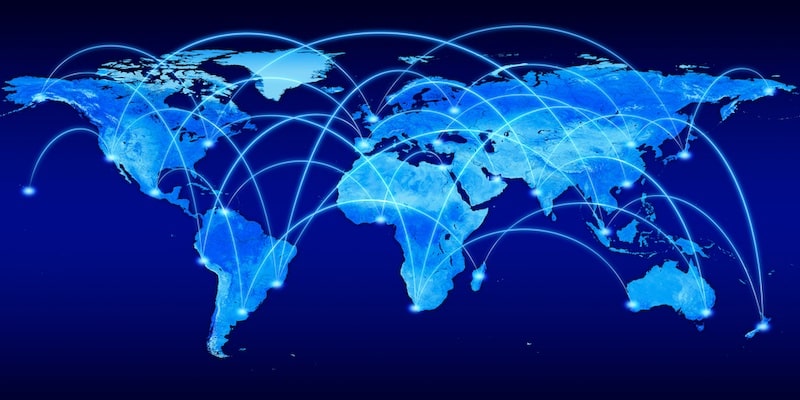We explain what the different types of globalization are: economic, political, social, cultural and technological. Also, its characteristics and examples.

What are the types of globalization?
Globalization is a complex phenomenon that is made up of several dimensions. There are five main types of globalization: economic, political, social, cultural and technological, all closely linked to each other. It is a global integration process which gained strength from the mid-20th century and currently benefits from new information and communication technologies (ICT).
Its main driving force is economic globalization, which involves the integration of markets through free trade, but this integration depends largely on technological globalization, which makes advances in areas such as computing and communication available to different countries. In turn, this is related to political globalization, which facilitates coordination between countries and overcoming border barriers. These changes impact society and culture, which experience transformations in their identities, customs, values, tastes, consumption, mobility, work and rights.
See also:
- Globalization
- Causes and consequences of globalization
Economic globalization
economic globalization It is the process of integration of the economies of the different countries of the world. It is based on free trade and the free flow of capital, which constitute a global market for goods and services. This type of globalization depends largely on the signing of free trade agreements between countries, which allow the reduction or elimination of tariffs and obstacles to imports, but it also depends on computer technology and telecommunications (Internet and mobile telephony), which make it possible commercial and financial operations over long distances and immediately.
Some examples of economic globalization are:
- Free trade agreements (FTA) which facilitate exchanges between countries by reducing or eliminating some tariffs, such as the North American Free Trade Agreement signed between Canada, the United States and Mexico.
- International trade and financial organizations such as the World Trade Organization (WTO), which supervises and promotes international trade exchanges, or the International Monetary Fund (IMF), which provides financial assistance to governments in exchange for demands for fiscal adjustment.
- multinational companies which have their main headquarters in one country but establish subsidiaries and market their products in various parts of the world, such as McDonald's gastronomic franchises, the Carrefour supermarket chain or technological giants such as Google, and even some companies that set up their factories in other countries. countries where they get cheap labor, like the Nike plants in Asian countries.
- Banking internationalization by which banks from a nation establish themselves and carry out operations in other countries, such as the Chinese banks Industrial and Commercial Bank of China (ICBC) and China Construction Bank Corporation (CCB), with growing prominence in Europe and America.
- The digital economy which thanks to new technologies allowed the development of online buying and selling platforms such as Amazon or AliExpress, digital banks, virtual wallets, cryptocurrencies, security services. streamingmonetization through social networks, collaborative work platforms, among others.
See also: Economic globalization
Political globalization
political globalization It is the set of institutions and instruments designed to coordinate the political agendas of different countries in relation to common objectives or with the resolution of mutual disputes. Through agreements or integration processes, the path towards a kind of global governance is being outlined, although there are still blocks facing geopolitical conflicts. This process of political integration not only involves national states, but also civil society organizations, such as non-governmental organizations (NGOs) that have international representation.
Some examples of political globalization are:
- International institutions with global reach such as the United Nations (UN), the International Criminal Court (ICC) or the World Health Organization (WHO), which have powers in specific areas that involve the world population.
- The European Union which was born as an economic community aimed at establishing a common market and became a supranational political community with a governmental structure made up of national governments and other representatives of the Member States.
- International non-governmental organizations (NGOs) such as Amnesty International or World Wide Fund for Nature, which sometimes coordinate actions together with governments and public international organizations.
- Regional organizations and international forums such as the Organization of American States (OAS) or the Group of Twenty (G20), which bring together representatives of different governments to debate and agree on common criteria on diverse areas, such as security, sovereignty, sustainable development, financial stability or the defense of democracy and human rights.
See also: Political globalization
Social globalization
Social globalization It is the form of interaction between people made possible by the growing global economic, political and technological integration. It consists of new types of social relationships that transcend national borders, such as emotional or recreational links that arise in social networks, distance work initiatives or opportunities, virtual educational training cycles, cultural exchanges, physical trips for tourism, studies or work, among others. others. It also involves the exchange of ideas and information and the possibility of applying international pressure on specific governments to guarantee rights and freedoms.
Some examples of social globalization are:
- The popularization of social networks such as Facebook, Instagram, X (ex-Twitter) or TikTok, which connect people from different corners of the world for emotional, work, recreational, informative, cultural or political reasons.
- The new job category of “digital nomad” which refers to people who do remote work thanks to the use of new communication technologies (computer science, Internet, smart cell phones).
- The expansion of tourism and other forms of mobility which encourages contact between neighboring or distant populations and promotes knowledge of their respective customs and histories.
- The generalization of rights made possible by the exchange of information that makes it possible to spread the freedoms of some countries and denounce the oppressions of others, organize protests through social networks and generate international pressure through independent initiatives or through organizations such as the UN.
See also: Social globalization
Cultural globalization
cultural globalization is the dissemination and exchange of customs, traditions, values and cultural products between different countries which produces transformations such as the integration of aspects of one culture into another and the emergence of new hybrid forms as a result of their combination or fusion. This process is directly related to the global integration promoted by other types of globalization.
Although cultural globalization can generate mutual enrichment, it also tends toward homogenization that responds to the expansion of the cultural characteristics of the economically and technologically dominant countries.
Some examples of cultural globalization are:
- The global success of Hollywood cinema and television series or streaming of the United States, which communicate ideas, values and customs characteristic of American society to other cultures.
- international fashion which imposes clothing and accessory trends that cross borders and favor a certain standardization, especially with the installation of big brand stores in different cities around the world and the possibility of buying online.
- The gastronomic diversity which allows you to consume dishes from different regions of the world in practically every city on the planet thanks to restaurants specialized in certain gastronomic cultures, to which is added fusion cuisine, which combines elements from different culinary traditions.
- The dissemination and combination of musical, literary or artistic styles such as the international success of rock, the development of fusion styles such as worldbeatthe collaboration between musicians and artists from different continents in recordings or concerts, the physical and online marketing of literary works from around the world and the circulation of works of art from different cultures through museums and galleries.
- Global interest in national and international sporting events such as the Formula 1 world championship, the European soccer Champions League or the NBA basketball league in the United States, which are followed around the world through television.
See also: Cultural globalization
Technological globalization
Technological globalization is the worldwide expansion of the same types of technology, especially for telecommunications and their common use to facilitate exchanges. This type of globalization makes possible the processes that make up economic, political, social and cultural globalization, and at the same time, phenomena such as economic integration contribute to perfecting and expanding technology. Currently, the main tools of technological globalization are the Internet, cell phones and digital applications.
Some examples of technological globalization are:
- The expansion of the Internet, social networks and digital media which make the circulation of information possible quickly and on a global scale.
- Advances in mobile telephony especially with the development of smartphones or smartphones and, more recently, with 5G (the fifth generation of communication technology for cell phones), which provides greater speed and performance.
- The rise of the digital economy which allows the purchase and sale of goods and services through digital platforms and applications (such as Amazon, eBay or Uber), the use of virtual wallets, the opening of accounts in digital banks, remote collaborative work, among others.
- The development of technology blockchain which enables the exchange of cryptocurrencies and other digital assets (such as NFTs or non-fungible tokens), and favors decentralized exchanges.
document.addEventListener(“DOMContentLoaded”, (e) => {
var sliderContainer, slider;
sliderContainer = document.getElementById(‘block_196061eb09d3a89dd031e50d5d107003’);
if (typeof initSlider !== ‘function’) {
console.log(‘Swiper haven\’t been loaded’);
sliderContainer.className += ‘ fw scroll-snap’;
return;
};
options = {
direction: ‘horizontal’,
speed: 1000,
slidesPerView: ‘auto’,
// slidesPerGroup: 1,
centerInsufficientSlides: true,
// centeredSlides:true,
spaceBetween: 15,
breakpoints: {
720: {
// centeredSlides: false,
// slidesPerGroup: 2,
spaceBetween: 25
},
},
pagination: {
el: ‘.swiper-pagination’,
type: ‘bullets’,
clickable: true
},
}
slider = initSlider(sliderContainer, options);
})
References
- Bauman, Z. (2001). Globalization. Human consequences. Economic Culture Fund.
- Hashemi-Pour, C and Lutkevich, B. (2023). Globalization. TechTarget. https://www.techtarget.com/
- Lechner, F.J. (2009). Globalization. The Making of World Society. Wiley-Blackwell.
- Osterhammel, J and Petersson, N. (2019). Brief history of globalization. From 1500 to the present day. 21st century.
- Volle, A. (2024). Globalization. Britannica Money. https://www.britannica.com/





